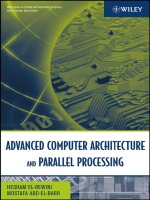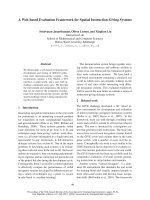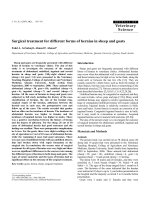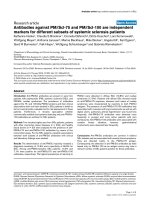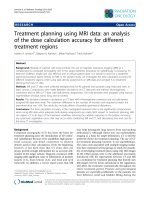Computer architecture simulators for different instruction formats (1)
Bạn đang xem bản rút gọn của tài liệu. Xem và tải ngay bản đầy đủ của tài liệu tại đây (253.31 KB, 6 trang )
2019 International Conference on Computational Science and Computational Intelligence (CSCI)
Computer Architecture Simulators for Different
Instruction Formats
Xuejun Liang
Department of Computer Science
California State University – Stanislaus
Turlock, CA 95382, USA
programs to deal with arrays, subroutines, and recursions on
these computer architectures. Using these simulators to perform
their hands-on assembly language programming exercises,
students will be able to have a better understanding of computer
architectures. Students can also modify these simulators to add
more instructions, debugging functions, and etc. In addition,
these simulated machines can serve as the compiler’s target
machines for the code generation practice.
Abstract—Several simple computer architecture simulators are
developed and implemented for different instruction formats,
including stack-based, accumulator-based, two-address, and threeaddress machines. These simulators can be used to assemble and run
assembly language programs on the above computer architectures.
Several simple applications are used to illustrate how to develop
assembly language programs to deal with arrays, subroutines, and
recursions on these different computer architectures. Students will
have a better understanding of computer architectures by using these
simulators on their assembly language programming assignments.
In addition, students can also modify these simulators to add more
instructions, debugging functions, and etc.
For the simplicity, the microarchitectures that will support
the execution of instructions of these simulated machines are not
considered. The instruction sets implemented in these simulators
contain only basic integer arithmetic, branch, stack, load, store,
subroutine call and return, input, and output. Due to the limit of
space, only stack-based and accumulator-based machines will
be reported in detail in this paper. In the rest of this paper, the
simulated instruction sets are presented in Second II. Several
assembly language programming examples using these
simulators are described in Second III. Finally, Second IV will
conclude the papers.
Keywords—Computer Architecture, Simulator, Instruction
Format, Assembly Language Programming
I. INTRODUCTION
Assembly language programming and writing, using and
modifying processor simulators are major hands-on assignment
categories in an undergraduate computer architecture course [1].
There are many computer architectures with different instruction
formats such as stack-based, accumulator-based, two-address,
or three-address machine. But, in general, only one architecture
will be chosen for teaching assembly language programming in
a computer architecture class or textbook. David A. Patterson
and John L. Hennessy uses MIPS in their textbook [2]. Kip
Irvine teaches x86 in his textbook [3]. Linda Null and Julia
Lobur uses the accumulator-based architecture and the MARIE
simulator [4]. On the other hand, although there are numerous
processor simulators available [5], most simulators are for the
research purpose and using them needs a big learning curve. It
is certainly desirable to have various simple simulators, each for
one major computer processor architecture, so that students can
program and compare these processors.
II. INSTRUCTION SETS OF SIMULATED MACHINES
In simulated machines, all data are 32 bits and all addresses
and immediate data are 16 bits. All instructions in one simulated
machine are of the fixed word length which may be different for
different machines. Two separate memories are used for data
and instructions. Data is word addressable and a datum word is
32 bits. Instruction is also word addressable, but an instruction
word may not be 32 bits and it will depend on its particular
instruction format of simulated machine. So, each simulated
machine has 64K 32-bit words of data memory and 64K
instruction words of instruction memory.
In this paper, the notation M[A] represents the memory
content at memory address A. The acronym Imm stands for 16bit immediate number, PC for program counter, SP for stack
pointer, FP for frame pointer, and AC for accumulator.
To this end, six simple computer architecture simulators are
designed and implemented for different instruction formats,
including stack-based, accumulator-based, two-address, and
three-address machines. Both memory-to-memory and registerto-register architectures are considered for the two-address and
three-address machines. These simulators can be used to
assemble and run assembly language programs on the above
simulated computer architectures. Several simple applications
are used to illustrate how to develop assembly language
978-1-7281-5584-5/19/$31.00 ©2019 IEEE
DOI 10.1109/CSCI49370.2019.00153
In all simulated machines, stack will grow towards higher
memory address. SP and FP are registers in stack-based, and
two-address register-to-register, and three-address register-toregister machines, while SP is a reserved memory location and
FP is not available in accumulator-based, two-address memoryto-memory, and three-address memory-to-memory machines.
806
Authorized licensed use limited to: University of Exeter. Downloaded on July 02,2020 at 10:40:21 UTC from IEEE Xplore. Restrictions apply.
A. Stack-Based (Zero-Address) Instruction Set
Table 1 lists all instructions of the simulated stack-based (or
zero-address) machine. This instruction set includes 5 integer
arithmetic instructions, 5 branch instructions, 1 subroutine call
and 1 return instructions, 10 stack operations, 2 instructions to
manipulate with SP and FP, 1 input and 1 output instructions,
and finally, 1 stop instruction to terminate the program.
B. Accumulator-Based (One-Address) Instruction Set
Table 2 lists all instructions of the simulated accumulatorbased (or one-address) machine. This instruction set includes 6
integer arithmetic instructions, 1 load immediate instruction, 5
branch instructions, 1 subroutine call and 1 return instructions,
1 GET and 1 GETI instructions, 1 PUT and 1 PUTI instructions,
1 input and 1 output instructions, and finally, 1 stop instruction
to terminate the program.
The operational stack and activation record (stack frame) for
subroutine calls share the same stack inside the data memory.
The notation FP+Imm is used to indicate a local variable inside
an activation record (stack frame). It is a memory address in the
stack frame with offset Imm.
The symbol Å in Table 2 means assignment. Var in Table 2
indicates a memory location. It can be a global variable name or
a local variable in the form of $+Imm whose memory address is
M[SP]+Imm. So, the instruction ADD $+4 means AC Å AC +
M[M[SP]+4]. Note that M[SP] is the content of SP and is
usually pointing to the top of stack.
Table 1: Stack-Based Instruction Set
op
Instruction
Explanation
0
ADD
Pop the top two addends, add, and push the sum
1
SUB
Pop the subtrahend and minuend, subtract, and
push the difference
2
MUL
Pop the multiplicand and multiplier, multiply,
and push the product
3
DIV
Pop the dividend and divisor, divide, and push
the quotient
4
REM
Pop the dividend and divisor, divide, and push
the remainder
5
GOTO Label
Unconditionally jump to the instruction at
address Label
6
7
8
9
10
BEQZ Label
BNEZ Label
BGEZ Label
BLTZ Label
JNS Label
Table 2: Accumulator-Based Instruction Set
Pop the top item and jump to Label if the
popped item is zero
Pop the top item and jump to Label if the
popped item is not zero
Pop the top item and jump to Label if the
popped item is greater than or equal to 0
Op
Instruction
Meaning
0
LIMM Imm
AC Å Imm
1
AIMM Imm
AC Å AC+Imm
2
ADD Var
AC Å AC+M[Var]
3
SUB
Var
AC Å AC-M[Var]
4
MUL Var
AC Å AC*M[Var]
5
DIV
AC Å AC/M[Var]
6
REM Var
AC Å AC%M[Var]
7
GET
Var
AC Å M[Var]
8
PUT
Var
M[A] Å AC
9
GOTO Label
PC Å Label
10
BEQZ Label
If AC = 0 then PC Å Label
Var
11
BNEZ Label
If AC ≠ 0 then PC Å Label
12
BGEZ Label
If AC ≥ 0 then PC Å Label
13
BLTZ Label
If AC < 0 then PC Å Label
Push the return address and transfer the control
to the instruction at address Label
14
JNS
Push the return address and PC Å Label
15
JR
Pop the return address into PC
16
READ
Read an input and save it to AC
17
PRNT
Print AC
18
STOP
Terminate the program
19
GETI Var
AC Å M[M[Var]]
20
PUTI Var
M[M[Var]] Å AC
Pop the top item and jump to Label if the
popped item is less than 0
11
JR nLoc
Pop the return address into PC and decrement
SP by nLoc
12
PUSH FP
Push the content of FP on stack
13
PUSH FP+Imm
Push M[FP+Imm] on stack
14
PUSH Imm
Push a 16-bit integer value Imm on stack
15
PUSH Var
Push M[Var] on stack
16
PUSHI Var
Push M[M[Var]] on stack
17
POP FP
Pop the top item into FP from stack
18
POP FP+Imm
Pop the top item into M[FP+Imm] from stack
19
POP Var
Pop the top item into M[Var] from stack
20
POPI Var
Pop the top item into M[M[Var]] from stack
21
SWAP
Swaps the top two items on the stack
22
MOVE
Copy content of SP into FP
23
ISP nLoc
Increase/decrease SP by nLoc
24
READ
Read an input and push it on stack
25
PRNT
Print the top item on stack
26
STOP
Terminate the program
Label
The assembler of simulated one-address machine provides
three pseudo-instructions. POP will remove the top item of stack
by reducing the stack pointer SP’s value by 1. TOP A will only
return the value of the top item of stack to A without changing
stack. PUSH A will increase the stack pointer SP’s value by 1
first and then save the value of A on the top of stack.
III. ASSEMLY LANGUAGE PROGRAM EXAMPLES
Any assembly language program of all simulated machines
consists of three parts: data (optional), code, and input (optional)
separated by a key word END.
The data part is used for declaring variables in memory. Each
declaration takes one line and consists of ID, Type, and Value.
ID is a variable name, Type indicates number of words the
807
Authorized licensed use limited to: University of Exeter. Downloaded on July 02,2020 at 10:40:21 UTC from IEEE Xplore. Restrictions apply.
variable value has, and Value is optional initial values of the
variable. The code part is for assembly language instructions.
Each instruction takes one line and precedes an optional label
immediately followed by ‘:’ symbol. The input part is used for
providing user input data. One input line contains only one word
(integer). In addition, users can add comments starting from //
symbol and until to the end of line. A comment cannot cross
multiple lines.
//Data
//Same as that in Figure 1.
END
//Code
L1:
GET
N
SUB
I
BEQZ
L3
GETI
PDAT
BGEZ
L2
PUT
TMP
LIMM
0
SUB
TMP
L2:
ADD
SUM
PUT
SUM
GET
I
AIMM
1
PUT
I
GET
PDAT
AIMM
1
PUT
PDAT
GOTO
L1
L3:
GET
SUM
PRNT
STOP
END
In the following subsections, two simple examples are used
to illustrate how to write assembly language programs to deal
with array, function, and recursion for the simulated machines.
The first example is to compute sum of absolute values of all
elements in an array. The second example is to compute
Fibonacci number, which is defined by
( )=
( − 1) +
( − 2)
<2
≥2
A. Sum of Absolute Values of Elements in Array
Figure 1 Shows stack-based assembly language program to
compute the sum of absolute values of array elements. In the
data section, an array variable DAT with 9 integers is declared
and initialized. Five other variables are also declared. The loop
starts by checking if N-I = 0. If yes, the program will exit the
loop and print the result. Otherwise, the program adds one array
element’s absolute value to SUM and then increase the array
index I and the array pointer PDAT for the next loop iteration.
//Data
I
SUM
N
TMP
PDAT
DAT
END
//Code
L1:
L2:
L3:
1
1
1
1
1
9
0
//array index
0
//sum
9
//number of elements in the array
0
//temporary location
DAT
//pointer to the array DAT
10 20 30 -40 50 60 70 80 -90
//array DAT
PUSH
PUSH
SUB
BEQ
PUSHI
PUSHI
BGEZ
PUSH
SWAP
SUB
PUSH
ADD
POP
PUSH
PUSH
ADD
POP
PUSH
PUSH
ADD
POP
GOTO
PUSH
PRNT
STOP
N
I
L3
PDAT
PDAT
L2
0
//N-I
//if (N-I)=0, done
//get an array element
//get the array element again
//if positive, skip
//else, negate
SUM
//add to sum
SUM
I
1
//increase index I by one
I
PDAT
1
//increase array address by one
PDAT
L1
SUM
//N-I
//if (N-I)=0, done
//get an array element into AC
//if positive, skip
//else, negate
//add to sum
//increase index I by one
//increase array address by one
//next element
//print sum
//terminate program
Figure 2: Accumulator-Based Code Using Array
Figure 2 shows accumulator-based assembly language code
to compute the sum of absolute values of array elements. This
program has the same data section as that in the stack-based
program. It also applys the same algorithm to compute the sum.
The difference is that the stack-based program needs to push the
the two input data on stack for an operation and to get the result
from stack, while the accumulator-based program needs to load
one of the two input data for an operation into accumulator AC
and to get the result from AC.
B. Binonacci Numbers
Three methods will be used to compute Fibonacci numbers.
The first is using a loop, the second using a function, and the
third using a recursive function.
1) Using a Loop,
Figure 3 shows C++ code that computes Fibonacci number
using a loop. The algorithm used in this C++ code will be used
(translated) in the assembly language programs later so that
comparisons can be made.
int main() {
//compute Fib(N)
int I, A, B, C, N
std::cin >> N;
//get input N, say 10.
if (N < 2)
C = N;
else {
A = 0; B = 1;
for (I = 2; I <= N; I++) {
C = B + A; A = B; B = C;
}
}
std::cout << C;
return 0;
}
//next element
//print sum
//stop
END
Figure 3: C++ Code: Compute Fibonacci Number
Figure 1: Stack-Based (Zero-Address) Code Using Array
808
Authorized licensed use limited to: University of Exeter. Downloaded on July 02,2020 at 10:40:21 UTC from IEEE Xplore. Restrictions apply.
Figure 4 shows the stack-based code to compute Fibonacci
number using a loop. In the data section, the same variables as
those in C++ code are declared. The program reads the input
and stores it in variable N. Then, it computes N-2 and checks if
N ≥ 2. If no, it stores the result in C, which is N itself, and goes
to print result. Otherwise, it computes the loop body (C = B+A;
A = B; B = C;), increases loop index I, and checks if I ≤ N. If
yes, it goes to next loop iteration. If no, it exists the loop and
prints the result.
//Data
I
N
C
B
A
END
//Code
1
1
1
1
1
READ
POP
PUSH
PUSH
SUB
BGEZ
PUSH
POP
GOTO
PUSH
PUSH
ADD
POP
PUSH
POP
PUSH
POP
PUSH
PUSH
ADD
POP
PUSH
PUSH
SUB
BLTZ
PUSH
PRNT
STOP
L1:
L2:
END
//Input
10
1
0
0
1
0
N
N
2
L1
N
C
L2
B
A
//index
//N
//Fib(N)
//Fib(N-1)
//Fib(N-2)
//read input
//N=input
//N-2
//if N>=2 go to loop body
//C=N
//go to print result
//beginning of loop body
C
B
A
C
B
I
1
//C = B+A
I
I
N
//I = I+1
L1
C
//Data
//Same as that in Figure 4
//Code
READ
PUT
N
PUT
C
SUB
I
BLTZ
L2
BEQZ
L2
L1:
GET
B
ADD
A
PUT
C
GET
B
PUT
A
GET
C
PUT
B
GET
I
AIMM
1
PUT
I
SUB
N
BLTZ
L1
L2:
GET
C
PRNT
STOP
END
//inputs
10
//N
//read input
//N=input
//C=N
//AC=N-1
//if N<1 done
//if N=1 done
//beginning of loop body
//AC=B+A
//C=B+A
//AC=B
//A=B
//AC=C
//B=C
//AC=I
//AC=I+1
//I=I+1
//AC=I-N
//if I
//terminate program
Figure 5: Accumulator-Based Code Using a Loop
Fib(N) should be stored on stack so that right after the function
returns, only the function result remains on the stack. Table 3
shows the stack frame of the function Fib. It contains input
N/output Fib(N), return address, and four local variables.
//A = B
//B = C
Table 3: Stack Frame of Function Fib
//I-N
//if I
//terminate program
//N
Address
Content
Explanation
FP-1
N/Fib(N)
Before call Fib(N)/after Fib(N) return
FP
RA
Return Address
FP+1
I
Local variable
FP+2
A
Local variable
FP+3
B
Local variable
FP+4
C
Local variable
Figure 6 shows stack-based code to compute Fibonacci
number using a non-recursive function. The read instruction
reads input and push it on top of stack. So, this program reads
input and then calls the function Fib immediately. After the
function returns, the print instruction prints the result on top of
stack.
Figure 4: Stack-Based Code Using a Loop
Figure 5 Shows accumulator-based assembly language code
to compute Fibonacci number. This program has the same data
section as that in the stack-based program. It applies the same
loop algorithm. Here, N-1 is computed to check if N < 2, instead
of computing N-2. Another difference is that the stack-based
program needs to push the data on stack for computation, while
the accumulator-based program needs to load one of the input
data into accumulator AC for computation.
Note that JNS instruction pushes return address on stack.
The first instruction of the subroutine Fib copies SP into FP.
So, FP points to the function return address and the input N is
pointed by FP-1. The next four sluts on stack are used for the
four local variables. Note that I, A, B, and C in the content
column in Table 3 are used to compare with variable names of
program in Figure 4. No local variable names can be defined,
instead, FP+Imm is used to represent local variable location.
2) Using a Non-Recursive Function
Now, consider writing a non-recursive function Fib to
compute Fibonacci number. It takes an integer N as input and
compute Fib(N) as output. Note that the input N should be
pushed on stack just before calling the function and the result
Note that Fib(N)=N when N<2. So, there is no need to store
result on stack when N < 2 as it is already there. Meanwhile,
809
Authorized licensed use limited to: University of Exeter. Downloaded on July 02,2020 at 10:40:21 UTC from IEEE Xplore. Restrictions apply.
right before Fib returns, the result should be stored on stack at
FP-1 and SP should point to the return address. Instructions
POP FP-1 and ISP -3 in Figure 6 are to achieve these.
Fib:
//No data
END
//Code
READ
JNS
PRNT
STOP
MOVE
PUSH
PUSH
PUSH
PUSH
PUSH
PUSH
SUB
BGEZ
GOTO
PUSH
PUSH
ADD
POP
PUSH
POP
PUSH
POP
PUSH
PUSH
ADD
POP
PUSH
PUSH
SUB
BLTZ
POP
ISP
JR
Fib:
L1:
L2:
Fib
FP SP
1
0
1
0
FP-1
2
L1
L2
FP+3
FP+2
//call Fib
//print result
//terminate program
//I=1
//A=0
//B=1
//C=0
//N
//2
//N-2
// if N>=2 go to loop body
//Fib(N)=N if N<2
//beginning of loop body
FP+4
FP+3
FP+2
FP+4
FP+3
FP+1
1
//C=B+A
FP+1
FP+1
FP-1
//I=I+1
L1
FP-1
-3
0
END
//Inputs
10
L2:
L3:
END
10
N
N
Fib
C
C
//I=1
//B=1
//A=0
//AC=N
//AC=N-1
//if N<1 done
//if N=1 done
//beginning of loop body
//AC=B+A
//C=B+A
//AC=B
//A=B
//AC=C
//B=C
//AC=I
//AC=I+1
//I=I+1
//AC=I-N
//if I
//store result on stack
Figure 8: Accumulator-Stack-Based Code Using NonRecursive Function (2)
//B=C
Figure 7 shows the main program of accumulator-based
code to compute Fibonacci number using a non-recursive
function. Figure 8 shows the function Fib. This program has the
same stack frame of function Fib as shown in Table 3 except
the frame pointer FP is replaced by the $ symbol. The main
program reads input, pushes it on stack, and then calls the
subroutine Fib. When the subroutine returns, it pops the result
off stack and prints the result. The subroutine Fib code is very
much like the code shown in Figure 5.
//I-N
//if I
//restore the stack
//return
Note that the subroutine Fib shown in Figure 8 does not use
any push instructions. Therefore, the stack point SP does not
change inside the subroutine and then there is no to use pop
instructions to restore the stack.
//N=10
0
0
1
$+1
$+3
-1
$+2
$-1
$+1
L3
L3
$+3
$+2
$+4
$+3
$+2
$+4
$+3
$+1
1
$+1
$-1
L2
$+4
$-1
//A=B
Figure 6: Stack-Based Code Using Non-Recursive
Function
//Data
N
1
C
1
END
//Code
//main program
READ
PUT
PUSH
JNS
TOP
POP
GET
PRNT
STOP
LIMM
PUT
PUT
AIMM
PUT
GET
SUB
BLTZ
BEQZ
GET
ADD
PUT
GET
PUT
GET
PUT
GET
AIMM
PUT
SUB
BLTZ
GET
PUT
JR
3) Using a Recursive Function
Table 4 shows the stack frame of recursive function Fib.
Before the function call, the input N should be pushed on stack.
Then function call pushes the return address on stack. As shown
in Figure 9, the subroutine will push the previous frame point
FP on stack to save it as successive calls will change FP. The
next two sluts in the stack frame at FP+1 and FP+2 are for
successive calls. Before the function returns, the result is stored
on stack frame at FP-2 and previous FP is restored.
//N: input
//C: result of fib(N)
//read input
//N=input
//push N on stack
//call Fib
//get and save fib(N)
//restore stack
//get Fib(N) from C
//print Fib(N)
Table 4: Stack Frame of Recursive Function Fib (Stack)
//terminate program
Figure 7: Accumulator-Stack-Based Code Using NonRecursive Function (1)
Address
Content
Explanation
FP-2
N/Fib(N)
Before call Fib(N)/after Fib(N) return
FP-1
RA
Return Address
FP
Prior FP
Previous FP
FP+1
(N-1)/Fib(N-1)
Before call Fib(N-1)/after Fib(N-1) return
FP+2
(N-2)/Fib(N-2)
Before call Fib(N-2)/after Fib(N-2) return
810
Authorized licensed use limited to: University of Exeter. Downloaded on July 02,2020 at 10:40:21 UTC from IEEE Xplore. Restrictions apply.
//compute Fib(N)
Fib:
PUSH
MOVE
PUSH
PUSH
SUB
BGEZ
GOTO
L1:
PUSH
PUSH
SUB
JNS
PUSH
PUSH
SUB
JNS
ADD
POP
L2:
POP
JR
END
//Inputs
10
FP
FP SP
FP-2
2
//compute Fib(N)
Fib:
GET
BNEZ
GOTO
L1:
AIMM
BNEZ
GOTO
L2:
PUT
GET
AIMM
PUT
JNS
GET
AIMM
PUT
GET
AIMM
PUT
JNS
GET
AIMM
PUT
GET
ADD
PUT
L3:
JR
END
10
//FP=SP
//N
//2
//N-2
//N>=2
//Fib(N)=N if N<2
//N
//1
//N-1
//call Fib(N-1)
//N
//2
//N-2
//call Fib(N-2)
//Fib(N-1)+Fib(N-2)
//store result at FP-2
//restore previous FP
L1
L2
FP-2
1
Fib
FP-2
2
Fib
FP-2
FP
0
//N=10
Figure 9: Stack-Based Recursive Function Fib
Table 5 shows the stack frame of recursive function Fib for
accumulator-based machine. Before the function call, the input
N should be pushed on stack. Then the function call from main
program pushes the return address on stack. The next two sluts
in the stack frame are for successive calls Fib(N-1) and Fib(N2), respectively. The first column of address in Table 5 shows
the use of stack frame for function Fib(N).
Address
Content
Explanation
$-3
N/Fib(N)
before/after
$-2
RA
Return Address
$
$-1
(N-1)/Fib(N-1)
before/after
$+1
$
(N-2)/Fib(N-2)
before/after
Fib(N-2)
$-1
$-2
$
$-1
$+1
$+2
//Input 10
support the use of array, the processor without general purpose
registers should provide indirect memory access instructions
such as PUSHI and GETI. Owing to the space, two-address and
three-address (memory-to-memory and register-to-register)
machine simulators are not presented here. In register-toregister machine, stack frame may not be needed for a nonrecursive subroutine. In a three-address machine, an assembly
language program uses a smaller number of instructions than
zero- or one-address machines.
Students can use these simulators for assembly language
programming assignments. They can also modify these
simulators to add more instructions and debugging tools. In
addition, these simulated machines can serve as the compiler’s
target machines for the code generation practice.
Table 5: Stack Frame of Recursive Function Fib (Accumulator)
Fib(N-1)
//AC=N
//Fib(N)=0 if N=0
//done
//AC=N-1
//Fib(N)=1 if N=1
//done
//store N-1 to $+1
//AC=SP
//AC=SP+1
//increase SP ($) by 1
//call Fib(N-1)
//AC=N
//AC=N-2
//store N-2 to $+1
//AC=SP
//AC=SP+1
//increase SP ($) by 1
//Call Fib(N-2)
//AC=SP
//AC=SP-2
//restore SP
//AC=Fib(N-1)
//AC=Fib(N-1)+Fib(N-2)
//store Fib(N) to $-1
Figure 10: Accumulator-Based Recursive Function Fib
Note that in order to call Fib(N-1) within Fib(N), the stack
pointer should point to N-1. This requires that SP increase by 1
before calling Fib(N-1). So, the value of $ is also increased by
1 as shown in the second column of address. Similarly, right
before calling Fib(N-2), SP and therefore $ are increased by 1
again as shown in the third column of address. Finally, the last
column in Table 5 is similar to the last column in Table 4.
Fib(N)
$-1
L1
L3
-1
L2
L3
$+1
SP
1
SP
Fib
$-2
-2
$+1
SP
1
SP
Fib
SP
-2
SP
$+1
$+2
$-1
REFERENCES
[1]
[2]
IV. CONCLUSIONS
[3]
In this paper, several computer architecture simulators are
presented. Several example assembly language programs are
also given. These examples illustrate many basic programming
concepts and techniques at the assembly language level. These
include dealing with array, loop, stack, function call and return,
parameter passing, local variables, and recursion. Because these
simulated machines contain very simple similar instruction set
and have the same assembly language program structure, it is
convenient to compare assembly language programming details
among different computer instruction formats. For example, to
[4]
[5]
[6]
Xuejun Liang, A survey of hands-on assignments and projects in
undergraduate computer architecture courses, in Proceedings of
International Joint Conferences on Computer, Information, and Systems
Sciences, and Engineering (CISSE 07), December 3-12, 2007.
David A. Patterson and John L. Hennessy, Computer Organization and
Design: The Hardware/Software Interface, 5th Edition, Morgan Kaufmann
Publishers, 2014.
Kip Irvine, Assembly language for x86 processors – access card, 8th
Edition, Pearson, 2020
Linda Null and Julia Lobur, The essentials of computer organization and
architecture, 5th Edition, Jones & Bartlett Learning, 2019
Luke Yen, Min Xu, Milo Martin, Doug Burger, and Mark Hill, “WWW
Computer
Architecture
Page,”
available
from:
/>Xuejun Liang, Loretta A. Moore, and Jacqueline Jackson, Programming
at different levels: a teaching module for undergraduate computer
architecture course, in Proceedings of the 2014 International Conference
on Frontiers in Education: Computer Science and Computer Engineering
(FECS’14), pp.77-83, Las Vegas, Nevada, USA, July 21-24, 2014.
811
Authorized licensed use limited to: University of Exeter. Downloaded on July 02,2020 at 10:40:21 UTC from IEEE Xplore. Restrictions apply.
